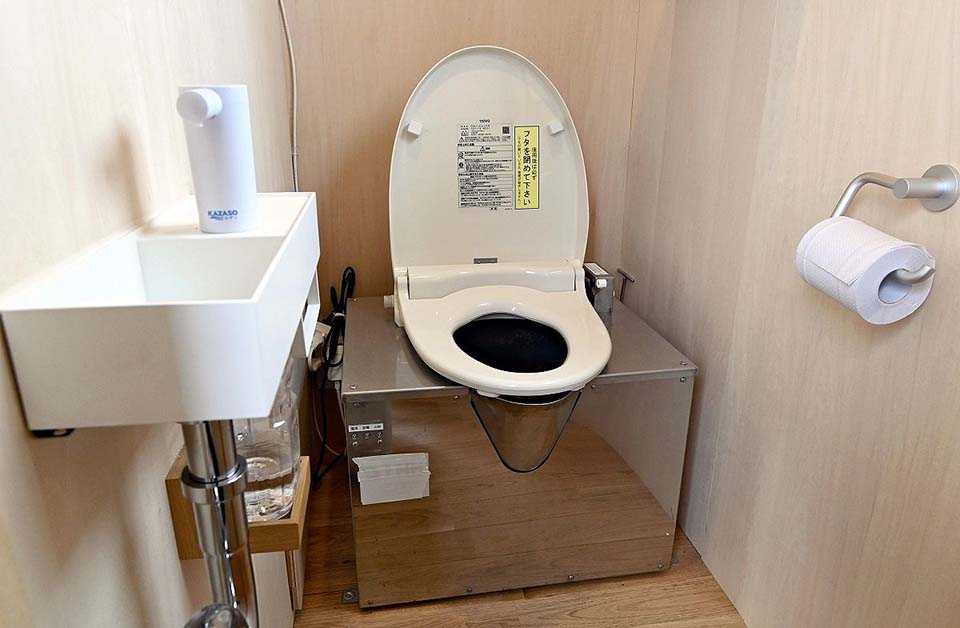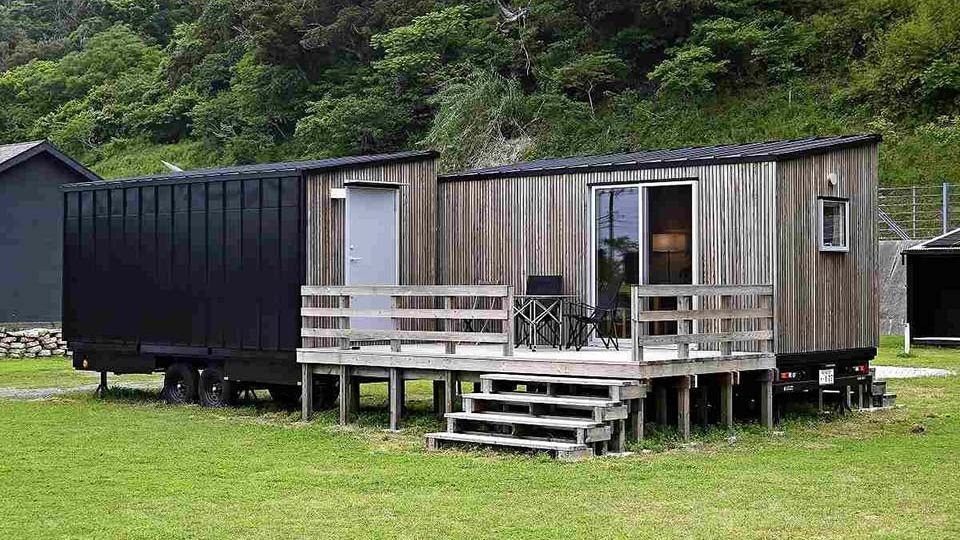July 1, 2024
CHIBA – In a rural part of Chiba Prefecture, a Tokyo housing construction company brought to reality a house that does not depend on the infrastructure.
There is no electricity or running water in the “net-zero house” that Muji House Co. constructed along the coast of Minami-Boso. The concept behind the project is how to live in an area with abundant nature but no infrastructure for utilities.
Muji House, a subsidiary of Ryohin Keikaku Co., unveiled its model house in April. The single-room abode measures 12 square meter, and is powered by solar panels on the roof and walls. Water for showers comes from a system that purifies and recycles household wastewater.
The toilet does not use water for flushing; instead, microorganisms break down the waste and toilet paper.

A water circulation system in the house. PHOTO: THE YOMIURI SHIMBUN

A bio-toilet. PHOTO: THE YOMIURI SHIMBUN
Muji House aims to commercialize the net-zero house, which has wheels and can be moved by a trailer, in 2025.
“This will be a model for housing in a society where depopulation and infrastructure maintenance will become serious issues,” said Koji Kawachi, director of the company’s product development department.
A number of companies have begun developing similar housing in line with the government’s carbon neutrality goal of reducing greenhouse gas emissions to net zero by the year 2050.
“A house which provides its own infrastructure may become the mainstream in 2050,” Kawachi said.

A storage battery. PHOTO: THE YOMIURI SHIMBUN
Delivery routes in the sky
The 1.7-meter-long drone loaded with daily necessities takes off from its logistics base — called the “drone depot” — in Kosuge, Yamanashi Prefecture.
The drone takes a direct course over thick forests before quietly landing in a clearing in a secluded village. It detaches the cargo and returns to the depot.
“With drones as part of the lifestyle infrastructure, we will be able to provide delivery services to anywhere in Japan,” said Keisuke Toji, the representative director of Aeronext Inc., a Tokyo-based drone development company.
Aeronext launched its drone delivery business in 2021, and now operates in eight municipalities across the country, all of which are experiencing depopulation. Shopping has become inconvenient for residents, and the remote locations make costs prohibitive for ordinary delivery companies.
Over the next few years, Aeronext expects to expand its business to more than 800 municipalities.
Toji envisions the sky being used like a road in 2050. “If the means of distribution can be secured, livelihoods can be maintained,” he said. “The day will come when people look back and say, ‘It was such a pain to go shopping in the old days.’”
Nomura Research Institute, Ltd. has found that more than 70% of roads, water pipes and other infrastructure will come due for upgrading in or after 2030. According to the Land, Infrastructure, Transport and Tourism Ministry, 75% of the nation’s 730,000 road bridges and 53% of the 11,000 tunnels will be more than 50 years old by 2040.
“It will be difficult to maintain the upkeep of all infrastructure,” said Toyo University Prof. Yuji Nemoto, a specialist in public policy. “We need to prioritize sustainability over convenience, and think in terms of ‘infrastructure reduction’ to ensure that we can keep what is most necessary.”
Concept of ‘2nd local government’
There are also changes afoot in administrative systems of rural areas.
“What a society with a declining population cries out for is mutual assistance,” said Atsushi Hayashi, co-representative director of Paramita, Inc., a Tokyo-based company that works to solve regional problems.
“It’s necessary for residents and businesses to work together to supplement municipal operations as a sort of ‘second local government.’”
A textbook case can be found in the Tsukigase district of Nara City, which has a population of about 1,200.
In April, a local cooperative launched by Parmita with residents and others began the collection of recyclable waste and a community bus service.
According to the municipal government and other entities, the initiative is aimed at raising the residents’ awareness of helping each other and encouraging them to get more involved. It ultimately will let residents decide how to use profits generated from the cooperative’s operations to the benefit of the local community.
“Hopefully, we’ll think about what we can do so that we can continue living here,” said Naoyuki Matsumoto, a father of three in Tsukigase.
Another unique project has been launched in the Yamakoshi district of Nagaoka, Niigata Prefecture, which was heavily damaged in a 2004 earthquake.
Dubbed the “Neo Yamakoshi Village Project,” it allows people living outside the area to purchase an electronic residency certificate issued by a private group called the Yamakoshi Residents Council.
A combination of reality and virtual space, the project connects about 1,700 “digital villagers” with local residents. They gather for online meetings or in Yamakoshi to address issues in the district.
“Even a small region can sustain itself by building a community of residents and others who share feelings for the area,” said Haruka Takeuchi, a representative of the council.
It is the declining population that is providing the impetus for residents to start considering the need for autonomy.
“Looking ahead, it will be necessary for residents to create communities on their own,” said Ritsumeikan University Prof. Noriko Nakanishi, who specializes in regional society. “Local governments will need to provide support for such efforts.”

